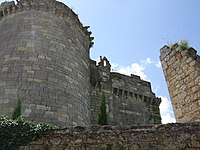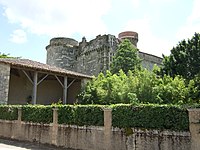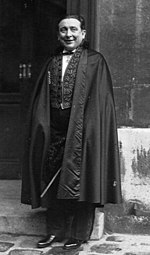Flamarens
| Flamarens | ||
|---|---|---|
|
|
||
| region | Occitania | |
| Department | Gers | |
| Arrondissement | Condom | |
| Canton | Lectoure-Lomagne | |
| Community association | Communes de la Lomagne Gersoise | |
| Coordinates | 44 ° 1 ′ N , 0 ° 48 ′ E | |
| height | 77-212 m | |
| surface | 14.36 km 2 | |
| Residents | 150 (January 1, 2017) | |
| Population density | 10 inhabitants / km 2 | |
| Post Code | 32340 | |
| INSEE code | 32131 | |
| Website | www.flamarens.fr | |
 Flamarens Castle at the beginning of the 20th century |
||
Flamarens is a French commune with 150 inhabitants (as of January 1, 2017) in the Gers department in the Occitanie region (before 2016: Midi-Pyrénées ). The municipality belongs to the Arrondissement Condom and the canton Lectoure-Lomagne (until 2015: canton Miradoux ).
The inhabitants are called Flamalingois and Flamalingoises .
geography
Flamarens is located about 34 kilometers east of Condom in Lomagne in the historic province of Armagnac on the northeast border to the neighboring Tarn-et-Garonne department .
Flamarens is surrounded by the five neighboring communities:
|
Sistels (Tarn-et-Garonne) |
Saint-Antoine | |
| Miradoux |

|
Mansonville (Tarn-et-Garonne) |
| Peyrecave |
Waters
Flamarens lies in the catchment area of the Garonne River .
The Ruisseau de Sirech, a tributary of the Garonne, has its source in Flamarens.
Tributaries of the Auroue cross the territory of the commune,
- the Ruisseau de Caussiac together with its tributary,
- the Ruisseau de Montret, and
- the Ruisseau du Métau.
In addition, Flamarens is irrigated by tributaries of the Arrats ,
- the Ruisseau de Pourchet together with its tributary,
- the Ruisseau de Pitoulens together with its tributary,
- the Ruisseau de Meynard, and
- the Ruisseau de Pitoulens together with its tributary,
- the Ruisseau de la Teulère.
history
The name of the community has its origin in the Frankish proper name "Flamarus" or "Flamarius". The ending “ens” indicates a Gothic or Franconian property in the fifth to sixth centuries, but for certain experts a Gallo-Roman estate.
The history of the Flamarens goes back to the early Middle Ages . But man has settled the area since ancient times, as evidenced by stone tools from the Neolithic period found in various places . Remains of a Gallo-Roman villa were discovered in 1970 in the hamlet of Maynard.
The village of Flamarens seems to have formed in several successive stages. A first Castelnau is said to have been built east of the castle in its extension on the same level. A Castelnau ( German Neuburg , Occitan castèl nòu , in Vulgar Latin castellum novum ) is a village or town that was founded near a castle in the Middle Ages . The suburb on the other side of the road then developed. Finally, a city wall surrounded the entire settlement. This is still visible in the north and south of the village and shows features of a construction from the end of the 13th or beginning of the 14th century. At the end of the 15th century and at the beginning of the following, the village seems to have been partially depopulated in favor of the surrounding hamlets.
Population development
After records began, the population rose to a high of around 545 by the first half of the 19th century. In the following period, the size of the community fell to its lowest level of 115 inhabitants before the first decade of the 21st century, with intermittent recovery phases a period of growth began that continues today.
| year | 1962 | 1968 | 1975 | 1982 | 1990 | 1999 | 2006 | 2011 | 2017 |
|---|---|---|---|---|---|---|---|---|---|
| Residents | 227 | 189 | 164 | 168 | 145 | 146 | 115 | 125 | 150 |
Attractions
Former parish church of Saint-Saturnin
The church was built in the 14th century and rebuilt in Gothic style in the first half of the 16th century by Arnaud de Grossoles, Seigneur of Flamarens, and nephew of Hérard de Grossoles, Bishop of Condom . The completion was in 1545, as evidenced by the date above the entrance portal . It is built on loose land, which consists mostly of embankment. This explains the successive collapse of the vault over the centuries and the work that was necessary for numerous reconstructions. The vault collapsed again in 1971. The ruins of the old church have been part of the supplementary inventory of historical monuments since 1993. Since then, work has been carried out to gradually stabilize and reconstruct the building. The church has been inscribed as a Monument historique since June 28, 1993 . Since then, work has been carried out to gradually stabilize and reconstruct the building.
The parish church of Flamarens is dedicated to Saint Saturnin . It is built in the flamboyant style. It consists of a rectangular nave with four bays and four side chapels of various sizes. The apse is pentagonal and there are two sacristies on either side. In the north-west of the building, a round tower adjoins the bell gable , with four round-arched recesses. The church was built from medium-sized limestone from local mining. The vault and roof are still gone. The entrance portal is from the early Renaissance . The entrance is flanked by columns with ornate capitals .
Flamarens Castle
A castrum was mentioned in the scriptures in 1289. Its origins go back to a castle in the 13th century. Extensions and changes followed in the following centuries. In June 1943 the castle was partially destroyed by fire as a result of a lightning strike. The castle has been classified as a Monument historique since March 9, 1965 .
Economy and Infrastructure
Flamarens is in the AOC zone of the Brulhois wine-growing region (rosé, rouge).

total = 15
sport and freetime
- The GR 65 long-distance hiking trail from Geneva to Roncesvalles leads through the center of the municipality. It follows the Via Podiensis , one of the four historic St. James' Ways .
traffic
Flamarens can be reached via Routes départementales 40, 49 (Tarn-et-Garonne: 30) and 953, the former Route nationale 653 .
Personalities
- Jean Tartanac, born April 10, 1759 in Flamarens, died in Agen on January 12, 1827 , was a French politician. He was from September 3, 1791 to September 20, 1792 member of the département in the Legislative National Assembly .
- Pierre Benoit , born on July 16, 1886 in Albi ( Département Tarn ), died on March 3, 1962 in Ciboure ( Département Pyrénées-Atlantiques ), was a French novelist and a member of the Académie française . In 1959 his novel "Flamarens" was published.
- Charles de Mazade , full name Louis Charles Jean Robert de Mazade – Percin, born on March 19, 1820 in Castelsarrasin , ( Département Tarn-et-Garonne ), died on April 19, 1893 in Paris , was a French poet , journalist and Writer and member of the Académie française. He was buried in his family grave in Flamarens.
Web links
- Flamarens on the association's website (French)
- Product sheet des Brulhois rosé (French)
- Product sheet des Brulhois rouge (French)
Individual evidence
- ↑ Gers ( fr ) habitants.fr. Retrieved December 22, 2019.
- ↑ Ma commune: Flamarens ( fr ) Système d'Information sur l'Eau du Bassin Adour Garonne. Retrieved December 22, 2019.
- ↑ Flamarens ( fr ) In: Société Archéologique et Historique du Gers - TOME 2 - COMMUNES DU DEPARTEMENT DU GERS - L'ARRONDISSEMENT DE CONDOM . Flamarens municipality. December 2014. Retrieved December 22, 2019.
- ^ Anaïs Comet: Village de Flamarens ( fr ) French Ministry of Culture . October 31, 2018. Retrieved December 22, 2019.
- ↑ Notice Communale Flamarens ( fr ) EHESS . Retrieved December 22, 2019.
- ↑ Populations légales 2016 Commune de Flamarens (32131) ( fr ) INSEE . Retrieved December 22, 2019.
- ^ Anaïs Comet: Église paroissiale Saint-Saturnin ( fr ) French Ministry of Culture . May 28, 2019. Retrieved December 22, 2019.
- ^ Ancienne église ( fr ) French Ministry of Culture . May 15, 2019. Retrieved December 22, 2019.
- ^ Château ( fr ) French Ministry of Culture . May 28, 2019. Retrieved December 22, 2019.
- ^ Château ( fr ) French Ministry of Culture . May 15, 2019. Retrieved December 22, 2019.
- ↑ Institut national de l'origine et de la qualité: Rechercher un produit ( fr ) Institut national de l'origine et de la qualité . Retrieved December 22, 2019.
- ↑ Caractéristiques des établissements en 2015 Commune de Flamarens (32131) ( fr ) INSEE . Retrieved December 22, 2019.
- ↑ GR® 65, le chemin de Compostelle via le Puy ( fr ) Fédération française de la randonnée pédestre . Retrieved December 22, 2019.
- ↑ Jean Tartanac ( fr ) French National Assembly . Retrieved December 22, 2019.
- ↑ Pierre BENOIT ( fr ) French Academy. Retrieved December 22, 2019.
- ↑ Charles de Mazade ( fr ) French Academy. Retrieved December 22, 2019.








